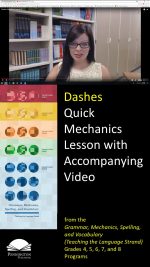Hyphens
Hyphens
Play the quick video lesson HERE and click the upper left back arrow to return to this lesson.
Common Core Language Standard 2
Hyphens are short dashes used to combine words. When the hyphen combines words and becomes part of common usage, the editors of our dictionaries decide to drop the hyphen and the two words become a compound noun. The only way to know whether the words are hyphenated or combined into a single compound word is to look up the word(s) in a print or online dictionary.
Today’s mechanics lesson is on how to use hyphens. A hyphen is a short dash (-) used to combine words. Hyphens join base words to form compound words. Hyphens are also used for numbers and spelled-out fractions. Additionally, hyphens join compound adjectives.
Now let’s read the mechanics lesson and study the examples.
Use hyphens for compound adverbs that don’t end in “_ly,” when used before nouns. A compound adverb has two connected adverbs. Example: The much-requested song
When the compound adverb is after the noun, don’t hyphenate. Example: Her wishes were always well known.
Now circle or highlight what is right and revise what is wrong according to mechanics lesson.
Practice: I woke up this morning at 7:30 AM. because I fell asleep last night at 10:00 p.m.
Let’s check the Practice Answers.
Mechanics Practice Answers: I woke up this morning at 7:30 a.m. because I fell asleep last night at 10:00 p.m.
Now let’s apply what we have learned.
Writing Application: Write your own sentence using a hyphen.
*****

Pennington Publishing Grammar Programs
Teaching Grammar, Usage, and Mechanics (Grades 4, 5, 6, 7, 8, and High School) are full-year, traditional, grade-level grammar, usage, and mechanics programs with plenty of remedial practice to help students catch up while they keep up with grade-level standards. Twice-per-week, 30-minute, no prep lessons in print or interactive Google slides with a fun secret agent theme. Simple sentence diagrams, mentor texts, video lessons, sentence dictations. Plenty of practice in the writing context. Includes biweekly tests and a final exam.
Grammar, Usage, and Mechanics Interactive Notebook (Grades 4‒8) is a full-year, no prep interactive notebook without all the mess. Twice-per-week, 30-minute, no prep grammar, usage, and mechanics lessons, formatted in Cornell Notes with cartoon response, writing application, 3D graphic organizers (easy cut and paste foldables), and great resource links. No need to create a teacher INB for student make-up work—it’s done for you! Plus, get remedial worksheets, biweekly tests, and a final exam.
Syntax in Reading and Writing is a function-based, sentence level syntax program, designed to build reading comprehension and increase writing sophistication. The 18 parts of speech, phrases, and clauses lessons are each leveled from basic (elementary) to advanced (middle and high school) and feature 5 lesson components (10–15 minutes each): 1. Learn It! 2. Identify It! 3. Explain It! (analysis of challenging sentences) 4. Revise It! (kernel sentences, sentence expansion, syntactic manipulation) 5. Create It! (Short writing application with the syntactic focus in different genre).
Get the Diagnostic Grammar, Usage, and Mechanics Assessments, Matrix, and Final Exam FREE Resource:
![]()







